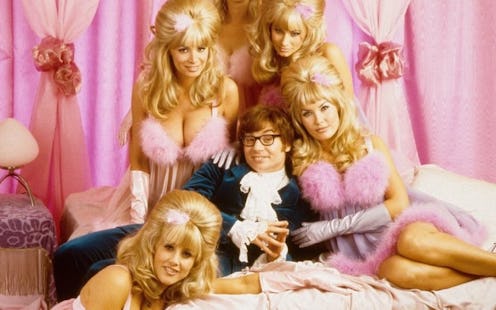Entertainment
'Austin Powers' Fembots Are Not As Funny As You Remember
Let me take you back to my first time watching Austin Powers: International Man of Mystery on VHS (hey, it's the '90s). It's 1997. I'm at a sleepover. My friends and I are laughing at all of the jokes and living for the colorful '60s set pieces. Then, all of a sudden, I was confronted with the stereotypically feminine fembots. With their Nancy Sinatra hair and shiny bikinis, shooting down men with their charms and with their deadly breasts, the fembots weirded me out with their explicit sexuality. 20 years later, those fembots in Austin Powers feel anti-feminist, making it all the more uncomfortable to watch as a woman who is very proud about the intersectionality feminist views she's cultivated since that sleepover.
In a film that is largely full of crass humor and spoofs of '60s culture, the sexual politics of Austin Powers feel more dated than ever. The way Austin Powers approaches its treatment of women feels so unnecessarily regressive. The fembots are simply mechanized sex machines that want to have sex with Austin Powers as badly as they want to kill him; what kind of an existence is that?
Austin Powers is established as a womanizing spy, a man who follows his heart as much as his mind and his man parts. His treatment of women and approach to sex is the way the audience is told to look at women and sex. It's all very male gaze-fueled and for women, that can make watching Austin Powers uncomfortable.
Those fembots are truly the worst aspect of this male gaze-driven approach to watching women in Austin Powers. When we're first introduced to them, "These Boots Are Made For Walkin'" by Nancy Sinatra starts play as a group of actual Nancy Sinatra lookalikes in tiny silver shorts, bras, boots, and long white gloves stomp out from a rotating platform.
A group of security guards are called into the room and ordered to shoot the fembots. However, they take one look at the women and their guns fall to their sides. They're somehow transfixed. The fembots can take aim with their — you'll never believe it — gun boobs. That's right: these fembots have guns for nipples. Does it make for a great visual pun? Hell yes. Does it also feel slightly weird to watch a man's vision of an ultra-feminine mechanized femme fatale shoot down a man with her gun boobs? You can bet your silver boots it does.
The next time we see the fembots, it's an all-out male sexual fantasy gone awry. Austin Powers successfully infiltrates the Virtucon factory and accidentally walks into a room full of fembots. What is a British spy who is literally irresistible — despite being an acknowledged average dude with horrible teeth — supposed to do? Austin Powers amusingly defeats the fembots, frying their circuits with by transfixing them through the power of a well-done striptease. Again, because the running joke is that Austin Powers is actually a very average-looking yet he manages to sleep with every woman he wants, his destruction of the fembots is quite anti-feminist.
In my opinion, the subtext of the fembots destruction is that women just cannot help themselves when a naked man is in front of them, and that even the most robotic of women — this is literal in the case of the fembots — are just sexual beings who need to be spoken to in sexual terms.
Instead of the film perhaps taking the opportunity to make a subversive comment against the '60s media portraying women as either sex symbols or housewives, Austin Powers reinforced those old-school ideals by making us believe it was simply parodying it when really it was feeding right into it with these damned fembots. 20 years later, the fembots in Austin Powers is just as reductive about women as it was in 1997 and, furthermore, the films of the '60s that Austin Powers was spoofing.
Time has not been kind to these robot women and we still see instances of the fembots in our film and television today. Westworld and Ex Machina are just two of the recent examples which grapple with the notions of robots as both female and simply sexual objects for male pleasure and dominance. While these modern fembots are given the opportunity to rebel against their male oppressors and reclaim some of their agency, it's to the detriment of their characterization that viewers are made to see them as sexual objects first. Call it "Residual Fembot Syndrome."
In 2017, we're still not totally out of the woods when it comes to aggressively male gaze-driven female characters in film and television. The fembots are emblematic of the problem and, jarringly, even 20 years later it seems that problem has yet to be fixed.
